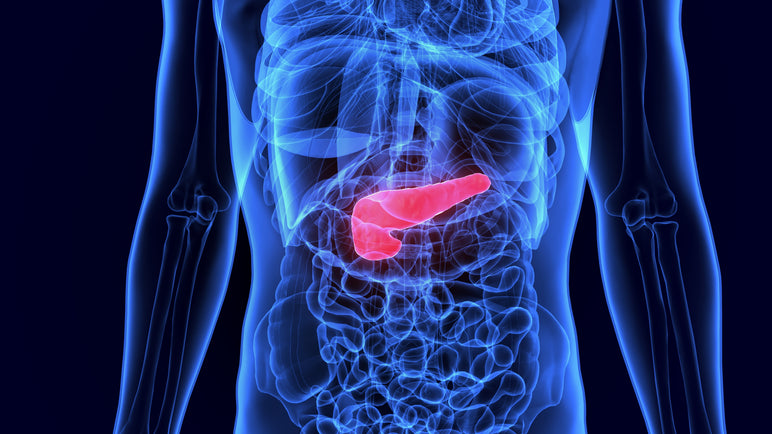To those outside of the medical professions, metabolic syndrome may seem like a relatively new phenomenon, and indeed the numbers of patients diagnosed with this particular syndrome have skyrocketed in the past decade. Research shows even young people - university students in the prime of life – are now showing signs of metabolic syndrome on a widespread basis. (1)
The etiology of metabolic syndrome was actually first recognized in the 1930’s by Himsworth, who questioned the understanding of his day, that all diabetes was caused by deficiency of insulin (as in Type 1 diabetes). He proposed that diabetes could also arise from inefficient action of insulin at the tissues – now called insulin resistance and understood to be the key step in the pathogenesis of Type 2 diabetes. (2)
In 1988, Gerald Reaven gave the name Syndrome X to the clustering of independent coronary heart disease (CHD) and Type 2 diabetes risk factors in the same patient, which included impaired glucose tolerance, high triglycerides, low HDL, and hypertension. (3)
Syndrome X,” or “the deadly quartet” is now known as metabolic syndrome. Metabolic syndrome is a group of risk factors that includes high blood pressure, high blood sugar, a large waist circumference, high triglycerides and low HDL. Each of these risk factors increases cardiovascular disease risk, and presentation of 3 or more is considered adequate to diagnose metabolic syndrome. All of the features of metabolic syndrome can be traced to one essential – and modifiable- cause: insulin resistance due in large part to lack of exercise, high glycemic diet and, in the majority of cases, obesity.
Unfortunately, many patients underestimate the risks of metabolic syndrome and overestimate the role of genetics in developing diabetes. Metabolic syndrome and Type 2 diabetes do have a genetic component – but the genetic predisposition is triggered by environmental factors that include sedentary lifestyle, high-fat refined-carbohydrate diet, and the development of abdominal obesity in particular.
Communicating the risks associated with insulin resistance, as well as educating patients about the effect of environment and behavior on genetic risk, may help improve compliance with nutrition and lifestyle changes, ultimately improving patient outcome.
Diet, lifestyle and nutritional interventions that have been shown to impact markers of metabolic syndrome include:
- Eating a whole food, plant-based diet that is low in refined sugars (including fructose) and starches. The Mediterranean Diet (4) and DASH Diet (5) have both been shown to reduce incidence of metabolic syndrome and improve various metabolic risk factors.
- Replacing red meat or processed red meat with white meat, fish, legumes or eggs is associated with lower risk of metabolic syndrome. (6) In fact, one recent study showed that replacing two servings of red meat with non-soy legumes, over a period of 3 days/week, improved plasma concentrations of inflammatory markers among overweight diabetic patients, independent of weight change (7).
- Choose organic foods whenever possible to avoid exposure to pesticides and other Persistent Organic Pollutants associated with obesity and diabetes risk.
- Focus on fitness – beginning in childhood. Childhood waist circumference and cardiorespiratory fitness are strongly associated with cardiometabolic health later in life (8). In healthy adults, 30-60 minutes of moderate exercise 5 days per week was associated with greater insulin sensitivity, improved lipid profile, and a decrease in components of metabolic syndrome, independent of any change in weight or BMI (9).
- Stress management and social network. Major life events and major events at work are risk factors for developing metabolic syndrome. While some stresses are unavoidable, specific interventions can help reduce the metabolic impact of stress. According to one study, seeking out a confidante and supportive social network can be most helpful for women, while men may benefit most from rest and relaxation practices to avoid exhaustion and intake of sleep medications – both of which increase risk of metabolic syndrome (10).
- Consider a protein supplement. In one study, adding a daily whey protein drink resulted in a small reductions in weight, fat, waist circumference, even without other dietary changes (11). Both whey and pea protein have been shown to reduce ghrelin (hunger hormone) levels and increase satiety (12, 13). Whey and pea protein also both help to preserve or increase lean muscle mass during caloric restriction when combined with resistance training (14), and whey is currently being studied for its effects on body composition and cardiometabolic risk factors in older adults with type 2 diabetes (15).
- Add fish oil. One recent study demonstrated that caloric restriction combined with fish oil and a high-protein powder reduced the severity of metabolic syndrome in women and increased the recovery from metabolic syndrome almost two-fold, compared to caloric restriction alone (16). Other research suggests that supplementing a low-fat, high-complex carbohydrate diet with long chain omega-3 fatty acids EPA and DHA favorably alters lipid metabolism in patients with metabolic syndrome (17).
- Ensure adequate Vitamin D status and mineral intake (Magnesium, Chromium, Zinc). Recent meta-analyses have suggested that low levels of magnesium (18), chromium (19) and/or zinc (20) may be associated with higher risk of metabolic syndrome. Other research indicates that patients with metabolic syndrome have a high prevalence of inadequate vitamin D, magnesium and calcium intakes (21)
- Berberine has been the focus of hundreds of studies in the past few years, many of which demonstrate its beneficial effects on glucose and lipid metabolism, hypertension, obesity and metabolic syndrome in both animal models and human clinical trials (22).
- Other insulin sensitizing herbs and nutrients include resveratrol (22), gymnema (22), American ginseng (23), fenugreek (24), and cinnamon (25), among others.
DISCLAIMER: The information contained in this article is for informational purposes only, and is not intended to be a substitute for professional medical advice, diagnosis, or treatment. Always seek the advice of your physician or other qualified health provider with any questions you may have regarding a medical condition.
References:
1) Barbosa, J. B., Santos, A. M. Dos, Barbosa, M. M., Barbosa, M. M., Carvalho, C. A. de, Fonseca, P. C. de A., … Silva, A. A. M. da. (2016). Metabolic syndrome, insulin resistance and other cardiovascular risk factors in university students. CieÌ‚ncia & saude coletiva, 21(4), 1123–36. doi:10.1590/1413-81232015214.10472015
2) Reaven, G. M. (2005). Why Syndrome X? From Harold Himsworth to the insulin resistance syndrome. Cell metabolism, 1(1), 9–14. doi:10.1016/j.cmet.2004.12.001
3) Sarafidis, P. A., & Nilsson, P. M. (2006). The metabolic syndrome: a glance at its history. Journal of hypertension, 24(4), 621–6. doi:10.1097/01.hjh.0000217840.26971.b6
4) Garcia, M., Bihuniak, J. D., Shook, J., Kenny, A., Kerstetter, J., & Huedo-Medina, T. B. (2016). The Effect of the Traditional Mediterranean-Style Diet on Metabolic Risk Factors: A Meta-Analysis. Nutrients, 8(3). doi:10.3390/nu8030168
5) Asghari, G., Yuzbashian, E., Mirmiran, P., Hooshmand, F., Najafi, R., & Azizi, F. (2016). Dietary Approaches to Stop Hypertension (DASH) Dietary Pattern Is Associated with Reduced Incidence of Metabolic Syndrome in Children and Adolescents. The Journal of pediatrics. doi:10.1016/j.jpeds.2016.03.077
6) Becerra-Tomás, N., Babio, N., Martínez-González, M. Á., Corella, D., Estruch, R., Ros, E., … Salas-Salvadó, J. (2016). Replacing red meat and processed red meat for white meat, fish, legumes or eggs is associated with lower risk of incidence of metabolic syndrome. Clinical nutrition (Edinburgh, Scotland). doi:10.1016/j.clnu.2016.03.017
7) Hosseinpour-Niazi, S., Mirmiran, P., Fallah-Ghohroudi, A., & Azizi, F. (2015). Non-soya legume-based therapeutic lifestyle change diet reduces inflammatory status in diabetic patients: a randomised cross-over clinical trial. The British journal of nutrition, 114(2), 213–9. doi:10.1017/S0007114515001725
8) Schmidt, M. D., Magnussen, C. G., Rees, E., Dwyer, T., & Venn, A. J. (2016). Childhood fitness reduces the long-term cardiometabolic risks associated with childhood obesity. International journal of obesity (2005). doi:10.1038/ijo.2016.61
9) Caro, J., Navarro, I., Romero, P., Lorente, R. I., Priego, M. A., Martínez-Hervás, S., … Ascaso, J. F. (2013). Metabolic effects of regular physical exercise in healthy population. Endocrinologia y nutricion: organo de la Sociedad Española de Endocrinologia y Nutricion, 60(4), 167–72. doi:10.1016/j.endonu.2012.11.004
10) Pedersen, J. M., Lund, R., Andersen, I., Clark, A. J., Prescott, E., & Rod, N. H. (2016). Psychosocial risk factors for the metabolic syndrome: A prospective cohort study. International journal of cardiology, 215, 41–46. doi:10.1016/j.ijcard.2016.04.076
11) Baer, D. J., Stote, K. S., Paul, D. R., Harris, G. K., Rumpler, W. V, & Clevidence, B. A. (2011). Whey protein but not soy protein supplementation alters body weight and composition in free-living overweight and obese adults. The Journal of nutrition, 141(8), 1489–94. doi:10.3945/jn.111.139840
12) Chungchunlam, S. M. S., Henare, S. J., Ganesh, S., & Moughan, P. J. (2015). Dietary whey protein influences plasma satiety-related hormones and plasma amino acids in normal-weight adult women. European journal of clinical nutrition, 69(2), 179–86. doi:10.1038/ejcn.2014.266
13) Overduin, J., Guérin-Deremaux, L., Wils, D., & Lambers, T. T. (2015). NUTRALYS(®) pea protein: characterization of in vitro gastric digestion and in vivo gastrointestinal peptide responses relevant to satiety. Food & nutrition research, 59, 25622. Retrieved from http://www.pubmedcentral.nih.gov/articlerender.fcgi?artid=4400298&tool=pmcentrez&rendertype=abstract
14) Babault, N., Païzis, C., Deley, G., Guérin-Deremaux, L., Saniez, M.-H., Lefranc-Millot, C., & Allaert, F. A. (2015). Pea proteins oral supplementation promotes muscle thickness gains during resistance training: a double-blind, randomized, Placebo-controlled clinical trial vs. Whey protein. Journal of the International Society of Sports Nutrition, 12(1), 3. doi:10.1186/s12970-014-0064-5
15) Daly, R. M., Miller, E. G., Dunstan, D. W., Kerr, D. A., Solah, V., Menzies, D., & Nowson, C. A. (2014). The effects of progressive resistance training combined with a whey-protein drink and vitamin D supplementation on glycaemic control, body composition and cardiometabolic risk factors in older adults with type 2 diabetes: study protocol for a randomized c. Trials, 15, 431. doi:10.1186/1745-6215-15-431
16) Su, H.-Y., Lee, H.-C., Cheng, W.-Y., & Huang, S.-Y. (2015). A calorie-restriction diet supplemented with fish oil and high-protein powder is associated with reduced severity of metabolic syndrome in obese women. European journal of clinical nutrition, 69(3), 322–8. doi:10.1038/ejcn.2014.196
17) Camargo, A., Meneses, M. E., Pérez-Martínez, P., Delgado-Lista, J., Rangel-Zúñiga, O. A., Marín, C., … López-Miranda, J. (2014). Dietary fat modifies lipid metabolism in the adipose tissue of metabolic syndrome patients. Genes & nutrition, 9(4), 409. doi:10.1007/s12263-014-0409-3
18) Sarrafzadegan, N., Khosravi-Boroujeni, H., Lotfizadeh, M., Pourmogaddas, A., & Salehi-Abargouei, A. (2016). Magnesium status and the metabolic syndrome: A systematic review and meta-analysis. Nutrition (Burbank, Los Angeles County, Calif.), 32(4), 409–17. doi:10.1016/j.nut.2015.09.014
19) Bai, J., Xun, P., Morris, S., Jacobs, D. R., Liu, K., & He, K. (2015). Chromium exposure and incidence of metabolic syndrome among American young adults over a 23-year follow-up: the CARDIA Trace Element Study. Scientific reports, 5, 15606. doi:10.1038/srep15606
20) Seo, J.-A., Song, S.-W., Han, K., Lee, K.-J., & Kim, H.-N. (2014). The associations between serum zinc levels and metabolic syndrome in the Korean population: findings from the 2010 Korean National Health and Nutrition Examination Survey. PloS one, 9(8), e105990. doi:10.1371/journal.pone.0105990
21) Da Cunha, A. T. O., Pereira, H. T., de Aquino, S. L. S., Sales, C. H., Sena-Evangelista, K. C. M., Lima, J. G., … Pedrosa, L. F. C. (2016). Inadequacies in the habitual nutrient intakes of patients with metabolic syndrome: a cross-sectional study. Diabetology & metabolic syndrome, 8, 32. doi:10.1186/s13098-016-0147-3
22) Martínez-Abundis, E., Méndez-Del Villar, M., Pérez-Rubio, K. G., Zuñiga, L. Y., Cortez-Navarrete, M., Ramírez-Rodriguez, A., & González-Ortiz, M. (2016). Novel nutraceutic therapies for the treatment of metabolic syndrome. World journal of diabetes, 7(7), 142–52. doi:10.4239/wjd.v7.i7.142
23) Yin, J., Zhang, H., & Ye, J. (2008). Traditional chinese medicine in treatment of metabolic syndrome. Endocrine, metabolic & immune disorders drug targets, 8(2), 99–111. Retrieved from http://www.pubmedcentral.nih.gov/articlerender.fcgi?artid=2467395&tool=pmcentrez&rendertype=abstract
24) Fuller, S., & Stephens, J. M. (2015). Diosgenin, 4-hydroxyisoleucine, and fiber from fenugreek: mechanisms of actions and potential effects on metabolic syndrome. Advances in nutrition (Bethesda, Md.), 6(2), 189–97. doi:10.3945/an.114.007807
25) Amiot, M. J., Riva, C., & Vinet, A. (2016). Effects of dietary polyphenols on metabolic syndrome features in humans: a systematic review. Obesity reviews: an official journal of the International Association for the Study of Obesity. doi:10.1111/obr.12409






